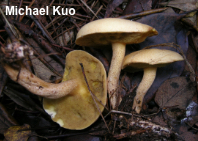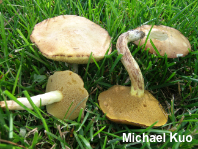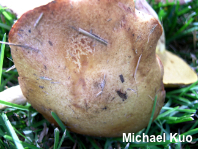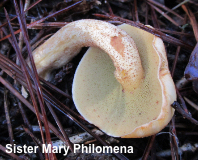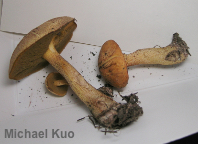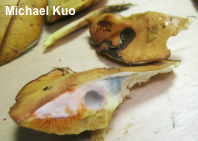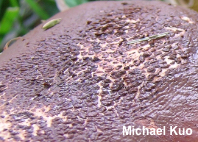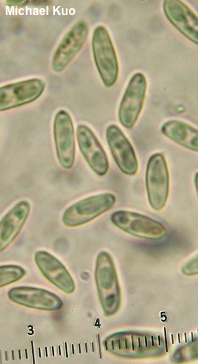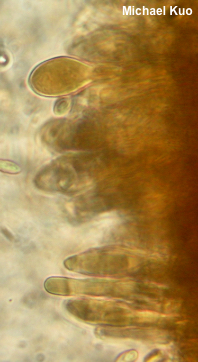| Major Groups > Boletes > Suillus > Suillus hirtellus |

|
[ Basidiomycota > Boletales > Suillaceae > Suillus . . . ] Suillus hirtellus by Michael Kuo, 22 June 2023 Suillus hirtellus is a mycorrhizal associate of hard pines (those with needles in bundles of 2 or 3) in the southeastern United States, or in places where these trees (primarily loblolly pine, shortleaf pine, and longleaf pine) have been planted as ornamentals or in out-of-natural-range plantations. Distinguishing physical features include a dull yellow cap, a pore surface that is yellow when young and matures to brownish yellow, and glandular dots—at first non-contrasting and hard to discern, but later brown and obvious—on a yellowish stem. The cap surface is finely fibrillose, but the fibrils are sometimes inconspicuous, requiring close inspection. Suillus weaverae is similar, but is strictly associated with eastern white pine and usually features a darker, browner cap. Suillus punctipes, also associated with eastern white pine, has a pore surface that is brown from the beginning. Suillus subaureus can be very similar in appearance, but features an orangish young pore surface that does not become brownish; additionally it develops reddish streaks on the cap, has flesh that often stains reddish when sliced (especially in the stem base) and, more definitively, is associated with oaks, aspens, and eastern white pine. Thanks to Sister Mary Philomena, O. P., for documenting, collecting, and preserving Suillus hirtellus for study; her collection is deposited in The Herbarium of Michael Kuo. Description: Ecology: Mycorrhizal with southern hard pines (those with needles in bundles of 2 or 3), including loblolly pine, shortleaf pine, and longleaf pine; growing gregariously in summer and fall or, in warm climates, over winter; originally described from New York (but see discussion on the page for Suillus subaureus); distributed primarily in the southeastern United States (the natural range of the host trees), or where the host trees have been planted as ornamentals or in plantations; also known from the Dominican Republic under Hispaniola pine (where it is often misidentified as "Suillus tomentosus"). The illustrated and described collections are from Georgia, Illinois, and Texas. Cap: 4–10 cm across; convex becoming broadly convex or nearly flat; sticky when fresh; usually finely fibrillose, at least over the center, with the fibrils sometimes darkening and, with age, aggregating into small scales—but also often appearing more or less bald without close inspection; dull yellow to orangish yellow, fading to brownish; young margin with a soft sterile edge that is sometimes fibrillose. Pore Surface: Dull yellow at first, becoming brownish yellow with age—or sometimes brownish throughout development; not bruising or, with age, bruising brownish; pores about 1 mm wide at maturity, angular, radially arranged; tubes up to 1 cm deep. Stem: 4–10 cm long; 1–1.5 cm thick; equal or with a tapering base; yellowish to orangish; with glandular dots that are initially concolorous with the stem surface and hard to see, but soon become brown and contrasting; without a ring; discoloring brownish where handled; basal mycelium white. Flesh: Yellow; not changing when sliced. Odor and Taste: Odor fragrant, or not distinctive; taste slightly lemony. Chemical Reactions: Ammonia negative on cap; red on flesh. KOH gray on cap; purple on flesh. Iron salts negative on cap; bluish on flesh. Spore Print: Dark cinnamon brown. Microscopic Features: Spores 6–11 x 2.5–4 µm; boletoid-fusiform; smooth; hyaline to yellowish in KOH. Basidia 22–26 x 5–6 µm; subclavate; 4-sterigmate. Hymenial cystidia in bundles; 40–60 x 6–12.5 µm; mostly clavate but occasionally cylindric, subcapitate, or subfusiform; brown in KOH. Pileipellis an ixocutis; elements 3–10 wide, smooth or encrusted, hyaline to brown in KOH; interspersed with upright aggregations of cystidioid elements (fibrils). REFERENCES: (C. H. Peck, 1889) C. O. Kuntze, 1898. (Coker & Beers, 1943; Singer, 1945; Smith & Thiers, 1964; Snell & Dick, 1970; Smith & Thiers, 1971; Smith, Smith & Weber, 1981; Weber & Smith, 1985; Metzler & Metzler, 1992; Both, 1993; Bessette et al., 2000; Ortiz-Santana et al., 2007; Bessette et al., 2016; Nguyen et al., 2016; Woehrel & Light, 2017; Elliott & Stephenson, 2018.) Herb. Kuo 09110901, 10170910, 12172202. This site contains no information about the edibility or toxicity of mushrooms. |
© MushroomExpert.Com |
|
Cite this page as: Kuo, M. (2023, June). Suillus hirtellus. Retrieved from the MushroomExpert.Com Web site: http://www.mushroomexpert.com/suillus_hirtellus.html |
